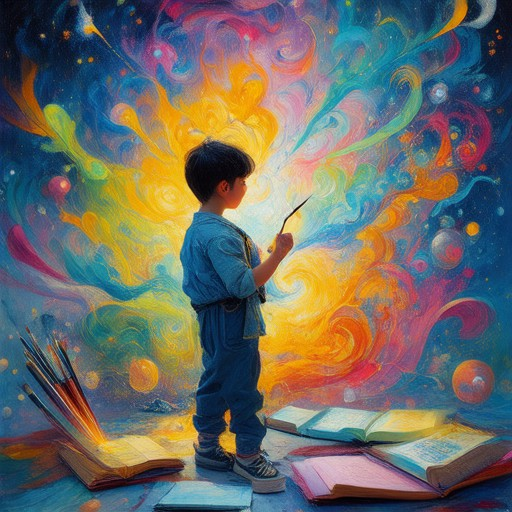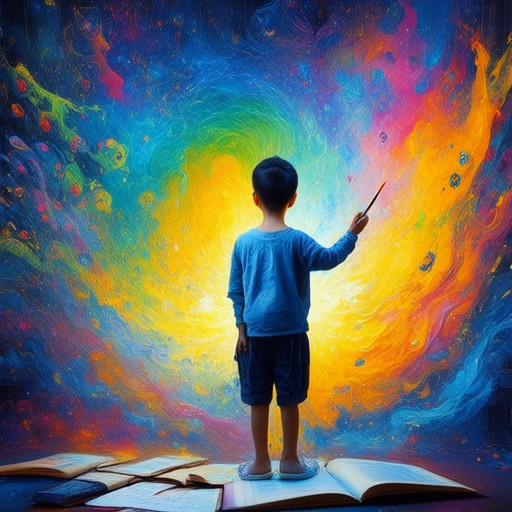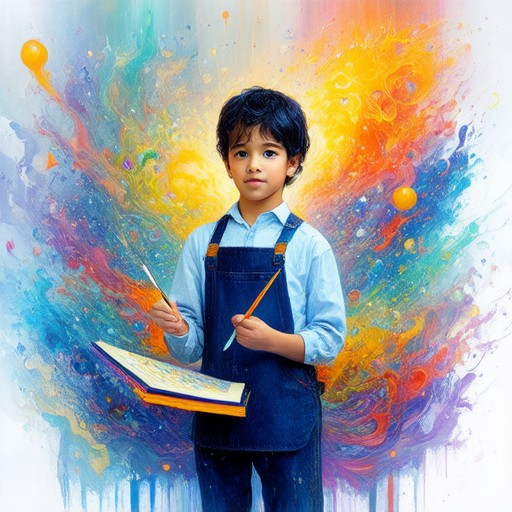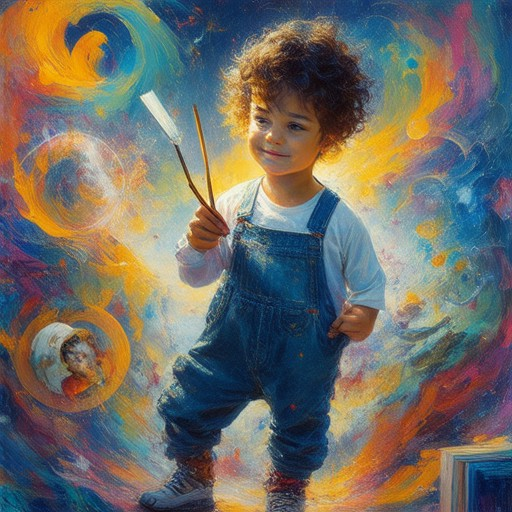Discover the transformative power of art education for young creators! In today’s fast-paced world, fostering creativity and self-expression has never been more essential. For aspiring young artists, the journey begins with the right guidance and resources. Whether you’re a parent, educator, or simply someone who believes in nurturing young talent, finding the perfect art tutorial for kids can unlock a world of possibilities. From mastering fundamental techniques to exploring unique styles, there’s no better way to inspire the next generation of artists. This guide delves into the best practices, platforms, and strategies to empower young artists, ensuring they have the tools and knowledge to thrive in their creative pursuits. Get ready to embark on a journey that celebrates imagination, builds confidence, and opens doors to endless opportunities!
Key Takeaways
– Build a Robust Online Presence: Use platforms like Instagram, Pinterest, and YouTube to showcase your artwork and connect with potential fans.
– Network and Collaborate: Engage with other artists and join online communities to expand your reach and opportunities.
– Enter Competitions and Exhibitions: Submit your work to art shows and galleries to gain visibility and recognition.
– Engage with Your Audience: Respond to feedback and share your creative journey to build loyalty and attract followers.
– Participate in Art Challenges: Join contests and challenges to gain exposure and potentially win awards.
– Stay Ahead of Trends: Follow artists and trends to inspire your work and make it more appealing to a broader audience.
– Seek Mentorship: Connect with experienced artists for guidance and to unlock new opportunities.
– Be Persistent and Adaptable: Keep refining your skills and submitting work to achieve long-term success in the art world.

First Things a Beginner Artist Should Learn
As a newcomer to art, mastering the fundamentals will lay the groundwork for your creative journey. Here’s a structured approach to help you excel:
- Understand Basic Shapes and Proportions
Begin by mastering essential shapes like circles, squares, triangles, and rectangles. These serve as building blocks for more complex forms. Practice sketching everyday objects to develop an eye for proportions, ensuring figures and settings appear natural and balanced. - Learn Perspective Drawing
Perspective gives your artwork depth and realism. Study how light and shadows interact to create three-dimensional effects. Practice still lifes or landscapes to apply this technique, making your scenes feel more lifelike. - Compose Thoughtfully
Composition involves arranging elements within a frame for maximum impact. Experiment with leading the viewer’s eye through your artwork using lines, symmetry, and balance. Consider focal points and negative space to enhance your designs. - Grasp Color Theory Basics
Understand how colors interact to create mood and harmony. Start with primary colors and learn how to mix them for secondary and tertiary hues. This knowledge will help you choose colors that complement each other and evoke desired emotions.
By focusing on these areas, you’ll build a strong foundation, allowing you to tackle more complex projects with confidence. Keep practicing, experiment, and study from great works of art to continually improve.
How to Teach Art to a 7-Year-Old
Teaching art to a 7-year-old requires a balance of creativity, engagement, and structure. Here’s a guide to effectively teach art to young children:
- Keep It Fun and Interactive: Young children thrive in dynamic environments. Incorporate movement, music, and storytelling to keep them interested.
- Use Visual Aids:** Display colorful posters, paintings, or photographs of famous artworks to inspire imagination and curiosity.
- Start with Simple Projects:** Begin with easy crafts like coloring, finger painting, or creating collages using household items.
- Storytime with Art: Read stories and encourage your child to illustrate scenes from the book. This helps develop their artistic skills and storytelling abilities.
- Explore Different Art Forms: Introduce your child to various mediums such as drawing, painting, sculpting with playdough, and collage-making.
- Use Educational Tools: Consider art kits designed for young children, which often come with age-appropriate tools and instructions.
- Encourage Creativity: Allow your child to experiment freely without criticism. This fosters a love for art and encourages self-expression.
- Set Up an Art Station: Create a dedicated space with art supplies, allowing your child to explore independently or with your guidance.
- Teach Color and Shape Recognition: Use flashcards or simple toys to help your child identify colors and shapes, which are essential for art creation.
- Be Patient and Positive: Celebrate every attempt and discuss their creations to deepen their understanding and appreciation of art.
By incorporating these strategies, you can create a meaningful and enjoyable art learning experience for your 7-year-old, fostering their creativity and enthusiasm for art.

Best YouTube Channels to Learn How to Draw
Learning how to draw effectively requires a combination of technique, inspiration, and guidance. Here are some of the top YouTube channels that can help you develop your drawing skills:
- Proko – Known for its detailed tutorials, Proko covers a wide range of drawing techniques, from traditional mediums like graphite and watercolor to digital tools. Their approach is highly regarded in the art community.
- Draw with Jazza – Specializing in digital art, Jazza’s channel is perfect for those interested in learning how to use software like Photoshop or Procreate. His tutorials are engaging and often feature fun, energetic teaching styles.
- Alphonso Dunn – Focused on portraiture, Alphonso Dunn’s channel is ideal for anyone looking to master drawing human figures. His methodical approach and deep understanding of anatomy make him a valuable resource.
- Artful Journey – This channel offers diverse courses in various mediums, including oils, pastels, and watercolor. They emphasize creativity and personal growth, making the learning experience both enjoyable and enriching.
Each of these channels provides a unique perspective and set of tools to help you improve your drawing skills. Whether you’re a beginner or an experienced artist, there’s something here for everyone.

How Young Artists Can Get Noticed
To help young artists gain recognition, consider the following organized approach:
- Build a Strong Online Presence:** Utilize platforms like Instagram, Pinterest, and YouTube to showcase your work. Regularly update your profiles and engage with followers to build a loyal audience.
- Network and Collaborate:** Attend art fairs, exhibitions, and join online communities such as Facebook groups or Reddit subreddits dedicated to art. Collaborate with other artists or brands for projects that align with your style.
- Submit Work to Competitions and Galleries:** Enter art competitions and apply to local galleries or online platforms that accept submissions. Winning awards or having work displayed can significantly boost your visibility.
- Engage with Your Audience:** Respond to comments and messages to foster connections. Create a personal website or blog to share your journey and attract followers interested in your unique perspective.
- Participate in Challenges and Contests:** Join art challenges or contests to gain exposure. These platforms often feature winners and provide opportunities for recognition and networking.
- Stay Informed About Trends:** Follow artists on social media, subscribe to art newsletters, and read blogs to stay updated on current trends. Incorporate these influences into your work to stand out.
- Seek Mentorship:** Network with experienced artists or mentors through events or online groups. Their guidance can offer valuable insights and open doors to new opportunities.
- Persist and Adapt:** Recognize that success takes time. Keep submitting work, engaging with your audience, and refining your skills. Persistence and adaptability are key to long-term success.
At What Age Do Most Artists Peak?
According to recent studies, 52 of the top 100 best-selling artists achieved their career-high success before turning 30, with the median age being 29. This aligns with the common belief that many creatives reach their peak earlier in life. [1]
However, the exact age at which an artist peaks can vary widely depending on their genre, dedication, and market conditions. For instance:
- Musicians often see their prime years during their 20s and early 30s, as seen with iconic figures like Music Legends Inc. .
- Visual artists may peak later, often in their 40s or 50s, due to the nature of their medium and evolving styles.
Factors like passion, innovation, and adaptability play significant roles in determining an artist’s peak age. Those who stay committed to their craft often continue to produce impactful work well beyond traditional peak ages.
In conclusion, while there isn’t a universal “peak age” for artists, the data suggests that many achieve their highest success in their 20s and 30s.

Who is the most successful young artist?
The title of “most successful young artist” can be subjective, as success is measured differently depending on the criteria—such as commercial success, critical acclaim, or cultural impact. However, based on recent reports and market analyses, several young artists have emerged as prominent figures in the contemporary art scene.
Below is a curated list of notable young artists making waves in the art world:
- Jeff Koons
Known for his playful and often controversial works, Jeff Koons has become one of the most recognizable contemporary artists. His sculptures and paintings frequently feature iconic imagery, blending pop culture with high art. - Takashi Murakami
A leading figure in the Japanese art scene, Murakami’s vibrant and whimsical works have gained international acclaim. His collaborations with major brands and exhibitions have significantly boosted his profile. - Banksy
While technically not a “young” artist anymore, Banksy remains a influential force in street art and activism. His anonymous street installations have inspired countless artists worldwide. - Kehinde Wiley
Renowned for his hyper-realistic portraits of everyday people, Wiley’s work bridges African traditions with contemporary themes, earning him widespread recognition and numerous awards. - Damien Hirst
Known for his provocative installations, Hirst’s work often challenges traditional norms and has been featured in major galleries and exhibitions globally. - Yayoi Kusama
Famous for her polka-dotted sculptures and installations, Kusama’s innovative approach to materials and space has made her a staple in the contemporary art scene. - Pablo Soler
Soler’s intricate and thought-provoking works often explore themes of identity and memory, resonating with audiences worldwide. - Anish Kapoor
Known for his large-scale installations, Kapoor’s work explores the relationship between geometry and space, captivating viewers with its abstract beauty. - Mark Bradford
A leader in the medium of abstraction, Bradford’s layered and dynamic compositions have earned him critical praise and numerous solo exhibitions. - Zhang Huan
Celebrated for his large-scale ink paintings, Zhang’s work delves into themes of history, memory, and personal narrative, attracting a global audience.
These artists represent a cross-section of the contemporary art landscape, showcasing diversity in style, technique, and subject matter. Their success is evident in their exhibitions, auctions, and critical reception, solidifying their positions as influential figures in the art world today.
Explore more inspiring artists




0 Comments